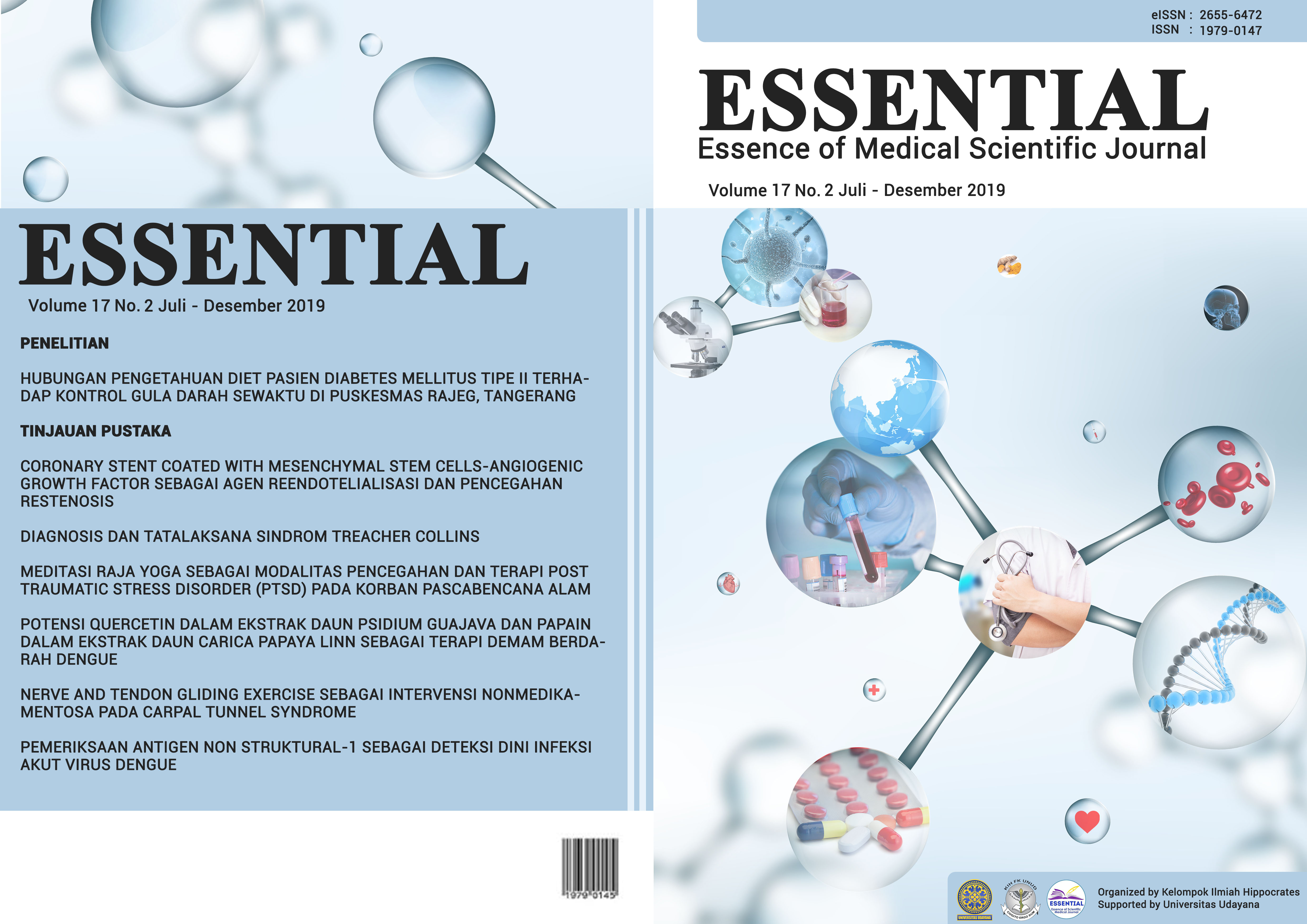CORONARY STENT COATED WITH MESENCHYMAL STEM CELLS-ANGIOGENIC GROWTH FACTOR SEBAGAI AGEN REENDOTELIALISASI DAN PENCEGAHAN RESTENOSIS
Abstract
ABSTRACT
Introduction: acute myocardial infarction (IMA) is the caused of medical emergencies with around 17.9 million global deaths. There are various factors associated such as unhealthy food dietary like high fat diet, sedentary lifestyle, smoking and alcohol. The pathogenesis of IMA begins with the formation of lesions atherosclerotic plaque that caused in decreased O2 perfusion (ischemia) and nutrition resulting in cardiomyocyte necrosis (infarction). The main treatment for overcoming IMA nowdays is percutaneous coronary intervention (PCI) using bare metal stents (BMS) with the disadvantage of achieving up to 50% restenosis. Innovations using drug eluting stent (DES) have not been efficient and led to restenosis and low reendothelization processes. New modalities that tends to have a better effect needed to increase reendothelization and prevent restenosis.
Discussion: the construction of coronary stents coated with mesenchymal stem cells (MSC) angiogenic growth factors begins with the formation of MSC culture and then using the TALEN system inserted plasmids containing HGF-VEGF gene. Then implanted in the CoCr stent and ready to be administrated. The resulting work effect is accelerating reendothelization through the proliferation and differentiation of MSC and strengthening the intima tunica by increasing the formation of tight junctions between epithelium. In addition, the effects taken in restenosis. This prevention is caused by immunomodulators and anti-inflammatory effects provided by angiogenic growth factors and induction of autophagi, thus recycling cell nutrients in atherosclerotic lesions.
Conclusion: the use of coronary stents coated with mesenchymal stem cell (MSC) angiogenic growth factors is needed as the latest IMA therapy with endothelial acceleration through the proliferation and differentiation of MSC and ancestral cells and the use of restenosis replacement through the use of antibacterial and nutrient recycling.
Downloads
References
2. Chistiakov DA, Bobryshev Y V., Orekhov AN. Macrophage-mediated cholesterol handling in atherosclerosis. J Cell Mol Med 2016;20(1):17–28.
3. Otsuka F, Kramer miranda C., Woudstra P, Yahagi K, Ladich E, Finn aloke V., et al. Natural Progression of Atherosclerosis from Pathologic Intimal Thickening to Late Fibroatheroma in Human Coronary Arteries: A Pathology Study. Atherosclerosis 2016;241(2):772–82.
4. Kastrati A, Mehilli J, Dirschinger J, Pache J, Ulm K, Schühlen H, et al. Restenosis after coronary placement of various stent types. Am J Cardiol 2001;87(1):34–9.
5. Buccheri D, Piraino D, Andolina G, Cortese B. Understanding and managing in-stent restenosis: A review of clinical data, from pathogenesis to treatment. J Thorac Dis 2016;8(10):E1150–62.
6. Pleva L, Kukla P, Hlinomaz O. Treatment of coronary in-stent restenosis: A systematic review. J Geriatr Cardiol 2018;15(2):173–84.
7. Daemen J, Wenaweser P, Tsuchida K, Abrecht L, Vaina S, Morger C, et al. Early and late coronary stent thrombosis of sirolimus-eluting and paclitaxel-eluting stents in routine clinical practice: data from a large two-institutional cohort study. Lancet 2007;369(9562):667–78.
8. Stettler C, Wandel S, Allemann S, Kastrati A, Morice MC, Schömig A, et al. Outcomes associated with drug-eluting and bare-metal stents: a collaborative network meta-analysis. Lancet 2007;370(9591):937–48.
9. Ertaş G, Van Beusekom HM, Van Der Giessen WJ. Late stent thrombosis, endothelialisation and drug-eluting stents. Netherlands Hear J 2009;17(4):177–80.
10. Shin D Il, Kim PJ, Seung K-B, Kim D Bin, Kim M-J, Chang K, et al. Drug-Eluting Stent Implantation Could Be Associated With Long-Term Coronary Endothelial Dysfunction. Int Heart J 2007;48(5):553–67.
11. Iso Y, Usui S, Toyoda M, Spees JL, Umezawa A, Suzuki H. Bone marrow-derived mesenchymal stem cells inhibit vascular smooth muscle cell proliferation and neointimal hyperplasia after arterial injury in rats. Biochem Biophys Reports 2018;16(October):79–87.
12. Wang C, Li Y, Yang M, Zou Y, Liu H, Liang Z, et al. Efficient Differentiation of Bone Marrow Mesenchymal Stem Cells into Endothelial Cells in Vitro. Eur J Vasc Endovasc Surg [Internet] 2018;55(2):257. Available from: https://doi.org/10.1016/j.ejvs.2017.10.012
13. Wu X, Wang G, Tang C, Zhang D, Li Z, Du D, et al. Mesenchymal stem cell seeding promotes reendothelialization of the endovascular stent. J Biomed Mater Res - Part A 2011;98 A(3):442–9.
14. Wang M, Yuan Q, Xie L. Mesenchymal stem cell-based immunomodulation: Properties and clinical application. Stem Cells Int 2018;2018.
15. Wu X, Zhao Y, Tang C, Yin T, Du R, Tian J, et al. Re-Endothelialization Study on Endovascular Stents Seeded by Endothelial Cells through Up- or Downregulation of VEGF. ACS Appl Mater Interfaces 2016;8(11):7578–89.
16. Huang C, Zheng X, Mei H, Zhou M. Rescuing Impaired Re-endothelialization of Drug-Eluting Stents Using the Hepatocyte Growth Factor. Ann Vasc Surg [Internet] 2016;36:273–82. Available from: http://dx.doi.org/10.1016/j.avsg.2016.07.001
17. Kraitzer A, Kloog Y, Zilberman M. Approaches for Prevention of Restenosis. 2007;1(c):583–603.
18. Chen C-H, Kirtane AJ. Stents, Restenosis, and Stent Thrombosis [Internet]. Fourth Edi. Elsevier Inc.; 2018. Available from: http://dx.doi.org/10.1016/B978-0-323-47671-3.00006-5
19. Bennett MR. In-stent stenosis: Pathology and implications for the development of drug eluting stents. Heart 2003;89(2):218–24.
20. Florence JM, Krupa A, Booshehri LM, Allen TC, Kurdowska AK. Metalloproteinase-9 contributes to endothelial dysfunction in atherosclerosis via protease activated receptor-1. PLoS One 2017;12(2):1–24.
21. Versari D, Lerman L, Lerman A. The Importance of Reendothelialization After Arterial Injury. Curr Pharm Des 2007;13(17):1811–24.
22. Noels H, Zhou B, Tilstam P V., Theelen W, Li X, Pawig L, et al. Deficiency of endothelial Cxcr4 reduces reendothelialization and enhances neointimal hyperplasia after vascular injury in atherosclerosis-prone mice. Arterioscler Thromb Vasc Biol 2014;34(6):1209–20.
23. Ohishi M, Schipani E. Bone marrow mesenchymal stem cells. J Cell Biochem 2010;109(2):277–82.
24. Crivellato E. The role of angiogenic growth factors in organogenesis. Int J Dev Biol 2011;55(4–5):365–75.
25. Ferrara N. Vascular Endothelial Growth Factor. Arterioscler Thromb Vasc Biol [Internet] 2009;2008–10. Available from: http://www.ncbi.nlm.nih.gov/entrez/query.fcgi?db=pubmed&cmd=Retrieve&dopt=AbstractPlus&list_uids=19164810
26. Nakamura T, Mizuno S. The discovery of Hepatocyte Growth Factor (HGF) and its significance for cell biology, life sciences and clinical medicine. Proc Japan Acad Ser B Phys Bol Sci 2010;86(6):588–610.
27. Chang HK, Kim PH, Kim DW, Cho HM, Jeong MJ, Kim DH, et al. Coronary stents with inducible VEGF/HGF-secreting UCB-MSCs reduced restenosis and increased re-endothelialization in a swine model. Exp Mol Med [Internet] 2018;50(9). Available from: http://dx.doi.org/10.1038/s12276-018-0143-9
28. Cho HM, Kim PH, Chang HK, Shen YM, Bonsra K, Kang BJ, et al. Targeted genome engineering to control VEGF expression in human umbilical cord blood-derived mesenchymal stem cells: Potential implications for the treatment of myocardial infarction. Stem Cells Transl Med 2017;6(3):1040–51.
29. Almalki SG, Agrawal DK. ERK signaling is required for VEGF-A / VEGFR2-induced differentiation of porcine adipose-derived mesenchymal stem cells into endothelial cells. 2017;1–14.
30. Rowart P, Erpicum P, Krzesinski JM, Sebbagh M, Jouret F. Mesenchymal Stromal Cells Accelerate Epithelial Tight Junction Assembly via the AMP-Activated Protein Kinase Pathway, Independently of Liver Kinase B1. Stem Cells Int 2017;2017:11–6.
31. Kim J, Kundu M, Viollet B, Guan K. AMPK and mTOR regulate autophagy through direct phosphorylation of Ulk1. Nat Publ Gr [Internet] 2011;13(2):132–41. Available from: http://dx.doi.org/10.1038/ncb2152
32. Hu C, Zhao L, Wu D, Li L. Modulating autophagy in mesenchymal stem cells effectively protects against hypoxia- or ischemia-induced injury. Stem Cell Res Ther 2019;10(1):1–13.
33. Becker A De, Riet I Van. Homing and migration of mesenchymal stromal cells : How to improve the efficacy of cell therapy ? 2016;8(3):73–87.
34. Xu T, Lv Z, Chen Q, Guo M, Wang X, Huang F. Vascular endothelial growth factor over-expressed mesenchymal stem cells-conditioned media ameliorate palmitate-induced diabetic endothelial dysfunction through PI-3K/AKT/m-TOR/eNOS and p38/MAPK signaling pathway. Biomed Pharmacother [Internet] 2018;106(April):491–8. Available from: https://doi.org/10.1016/j.biopha.2018.06.129
35. Iyer SS, Rojas M. Anti-infl ammatory effects of mesenchymal stem cells : novel. Expert Opin Biol Ther 2008;8(5):569–82.
36. Gallo S, Sala V, Gatti S, Crepaldi T. Cellular and molecular mechanisms of HGF / Met in the cardiovascular system. 2015;1173–93.
37. Kusunoki H, Taniyama Y, Otsu R, Rakugi H, Morishita R. Anti-inflammatory effects of hepatocyte growth factor on the vicious cycle of macrophages and adipocytes. 2014;37(6):500–6. Available from: http://dx.doi.org/10.1038/hr.2014.41
38. Qin L, Zhu N, Ao B, Liu C, Shi Y, Du K, et al. Caveolae and Caveolin-1 Integrate Reverse Cholesterol Transport and Inflammation in Atherosclerosis. 1:1–17.
39. Yang Y, Chen Q, Liu A, Xu X, Han J, Qiu H. Synergism of MSC-secreted HGF and VEGF in stabilising endothelial barrier function upon lipopolysaccharide stimulation via the Rac1 pathway. Stem Cell Res Ther [Internet] 2015;1–14. Available from: http://dx.doi.org/10.1186/s13287-015-0257-0
40. Yang L, Kwon J, Popov Y, Gajdos GB, Ordog T, Brekken RA, et al. Vascular endothelial growth factor promotes fibrosis resolution and repair in mice. Gastroenterology [Internet] 2014;146(5):1339-1350.e1. Available from: http://dx.doi.org/10.1053/j.gastro.2014.01.061
41. Han ZC, Plouet J, Sulpice E, Ding S, Berg M. Cross-talk between the VEGF-A and HGF signalling pathways in endothelial cells. 2009;101:525–39.
42. Chang H, Kim P, Cho H, Yum S, Choi Y, Son Y, et al. Inducible HGF-secreting Human Umbilical Cord Blood-derived MSCs Produced via TALEN-mediated Genome Editing Promoted Angiogenesis. :1–11.


 SUBMISSION
SUBMISSION
















